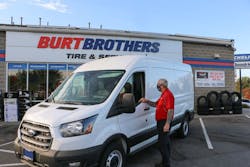As more consumers turn to online shopping, companies will continue to dot the map with distribution centers designed to expedite the delivery of goods.
Amazon alone has 110 distribution centers - or what it calls “fulfillment centers” - in North America.
This past July, Amazon announced that it was on track to add 33 fulfillment centers by the end of 2020, a push that will give it 35 million extra cubic feet of storage nationwide.
The proliferation of distribution centers will continue to boost the number of last-mile delivery vans like the Mercedes Sprinters and Ford Transits on local streets and roads. More than 29,700 Sprinter vans were sold in the U.S. during 2019, 2,000 more than were sold in 2018.
Nearly 154,000 Transit vans were sold in the U.S. during 2019, some 16,000 more than in 2018.
These models also are becoming increasingly popular with plumbing, HVAC and other service contractors, who are trading in their traditional vehicles.
All of the above means more tire and vehicle service opportunities for enterprising tire dealers, according to Terry Clifford, director of wholesale for Bountiful, Utah-based Burt Brothers Tire & Service Inc., and Jeremy Burt, one of the dealership’s owners.
Last-mile delivery companies, in particular, are growing “and that’s helping us grow, as well,” says Clifford.
In addition to providing tires to last-mile delivery and service fleets, “we also do a lot of oil changes and a ton of brake work - basically anything else they need to get their vans back on the road,” says Terry Clifford, director of wholesale for Burt Brothers Tire & Service.
'It’s not just tires’
Clifford estimates that last-mile and service fleets have grown to comprise around 5% of Burt Brothers’ overall revenue. That number is expected to increase as the COVID-19 pandemic continues.
“People have gotten into the habit of shopping online,” he says. “Nobody wants to leave their house” in the areas served by the dealership.
“They want everything delivered.”
That doesn’t mean that last-mile delivery fleets are the easiest type of customer to solicit, according to Clifford.
Convincing last-mile fleet managers to agree to initial meetings “sometimes requires an act of Congress,” he jokes.
“It’s kind of hard to get in the door,” confirms Jeremy. “It’s not all cut-and-dried.”
“They’re really busy,” notes Clifford. “In many cases, we work through relationships that we already have” at distribution centers.
“In our areas, there are 17 or 18 distribution centers,” he continues. “Out of that total, we do a lot of work for five or six of them. When their tires get down to 2/32nds or 3/32nds, they will send their vans over for new tires.
“We also do a lot of oil changes and a ton of brake work - basically anything else they need to get their vans back on the road.
“Primarily, they are looking for a tire that’s going to last,” says Clifford, when referring to last-mile delivery and service fleets.
“They have a guy on their payroll who is dedicated to checking out the vehicles on a daily basis. He calls me every afternoon to let me know how many vans he will send to us the next morning. We service delivery vans early in the day so they can return to terminals and start loading by 10.”
Ford Transits and Mercedes Sprinters are the most common last-mile delivery and service vans that the 14-outlet dealership services.
“The Fords take 235/65R16 C-type tires and the Sprinters take size 245/75R16 tires, standard load range E.”
Dodge Rams, which use size 225/75R16 C-type tires, also are becoming increasingly common, adds Clifford.
Some of Burt Brothers’ last-mile delivery and service fleet clients “have preferences” when it comes to replacement tire brands, he says.
“But they aren’t super-specific, though. Primarily, they are looking for a tire that’s going to last. They know which ones will and which ones won’t.
“They also know what tires will be competitive, price-wise. And in this part of the country, tires with all-weather capability are huge. Customers don’t want a snow tire in winter and another tire in the summer. They want a tire they can run year-round.”
Many of Burt Brothers’ last-mile fleet customers burn through tires quickly, according to Clifford. “Some are only getting 10,000 to 15,000 miles out of their tires” due to the harsh nature of the application, he says.
“But for us, it’s not just tires. We’re getting all the extra services, like oil changes and brakes. And by servicing those vehicles, we’ve made a lot of friends who bring their personal vehicles to us, as well.”
“We service delivery vans early in the day so they can return to terminals and start loading by 10,” says Clifford.
'Exponential growth’
More than 2,000 miles east of Utah, Bethlehem, Pa.-based Service Tire Truck Centers (STTC) also is making hay servicing last-mile delivery and service fleets.
“The exponential growth that has taken place -- I won’t even say during COVID-19, but over the last two to three years - has been in Class 1 and Class 2 equipment,” says Howie Harding, the dealership’s vice president of sales. “And a lot of those vans use light truck tires.”
Last-mile fleets, in particular, want quick service, he notes. “Uptime is key for those vans. They have a lot of deliveries to make in a short period of time and the morning time slot for them is very important. It’s essential for us to get in there, inspect their equipment and change their tires.
“We’ll even go through a checklist, looking at the overall vehicle - body panels, lights - to make sure the van is ready to go into service.”
Last-mile delivery fleets are logistics experts, not tire experts, according to Harding.
“They expect that we’re going to provide the right products, from a ply rating and load standpoint,” he says. “A lot of these vehicles are not over-the-road. They go into residential areas and tight alleyways so there is increased potential for curbing and other types of damage.”
STTC has expanded the menu of services it offers to these operations. “The way these distribution centers have been popping up has just been insane,” he says. “Some were even having their vans towed to us, just to have their tires changed.
“At our Baltimore location, we came up with a mounted tire and wheel exchange program. We said, ‘If you do business with us, we’ll go out and buy wheels for your vans, we’ll mount tires on them and we’ll have them ready to go. The minute you tell us you need tires, we’ll throw them on the truck, come to your location and put them on.’”
STTC also goes the extra mile by providing a wide range of tire maintenance services.
“We go in with a Michelin Tire Care device to check tread depth and air pressure,” says Harding. “As soon as we’re done, the data uploads into a cloud and we can email reports right to the fleet managers, so they get the information in real time.
“We have specs in place so we know when to replace their tires. If we see issues that need immediate attention, we don’t need to call to get approval. And we still provide paperwork, so if there is any question about why we sold them a certain amount of tires, they can refer to it.”
Problems that STTC can’t fix, like broken windshields or damaged body panels, are outsourced for repair. “We try to never say no,” says Harding.
“We’re always looking to expand our service offerings as these customers demand more. If you’re not fluid and aren’t looking to evolve as your customers’ business evolves, someone else will.”
On the uptick: Transit and Sprinter van sales continue to increaseSeeing more Ford Transits and Mercedes Sprinters around town? There’s a good reason. Sales of both vehicles continue to climb. Here’s a look at United States sales figures over the last five years, according to www.carfigures.com:
Year
Ford Transit
Mercedes Sprinter
2019
153,868
29,757
2018
137,794
27,564
2017
127,360
27,415
2016
143,244
26,151
2015
117,579
29,889
About the Author
Mike Manges
Editor
Mike Manges is Modern Tire Dealer’s editor. A 28-year tire industry veteran, he is a three-time International Automotive Media Association Award winner, holds a Gold Award from the Association of Automotive Publication Editors and was named a finalist for the prestigious Jesse H. Neal Award, the Pulitzer Prize of business-to-business media, in 2024. He also was named Endeavor Business Media's Editor of the Year in 2024. Mike has traveled the world in pursuit of stories that will help independent tire dealers move their businesses forward. Before rejoining MTD in 2019, he held corporate communications positions at two Fortune 500 companies and served as MTD’s senior editor from 2000 to 2010.

